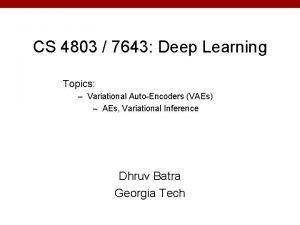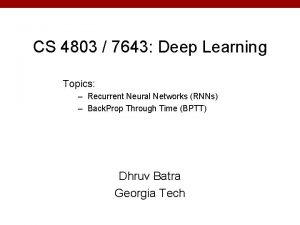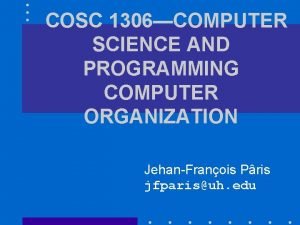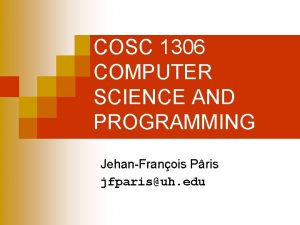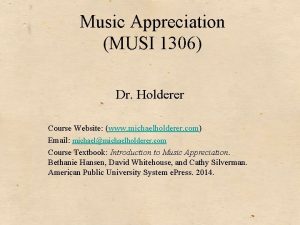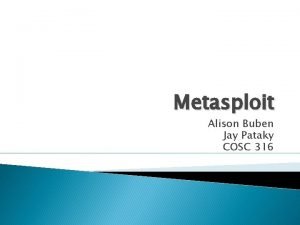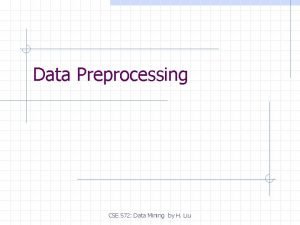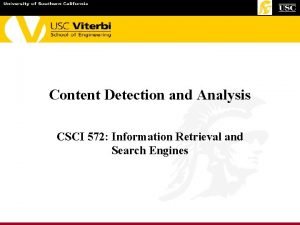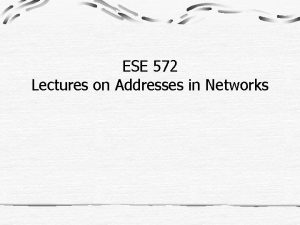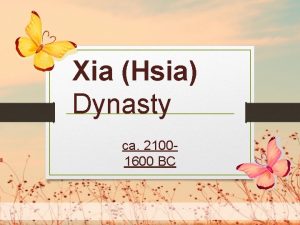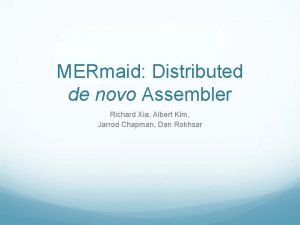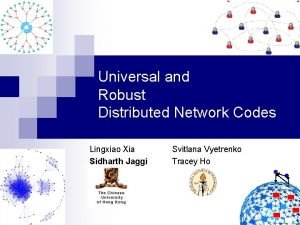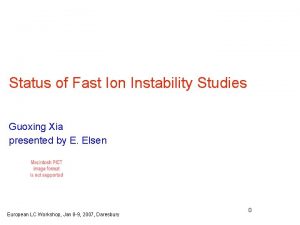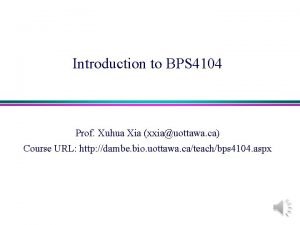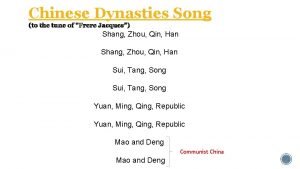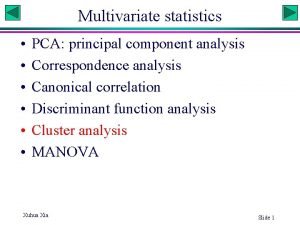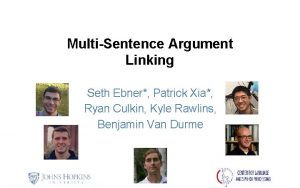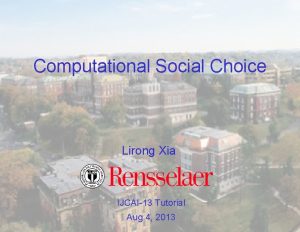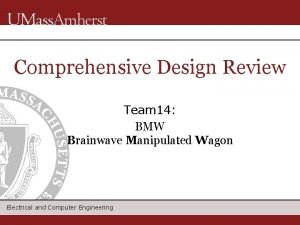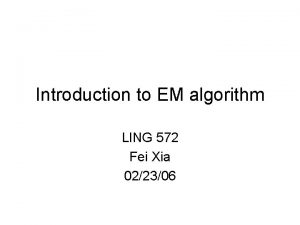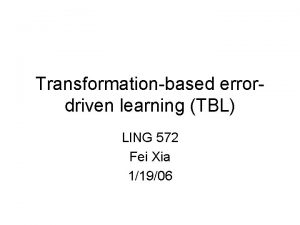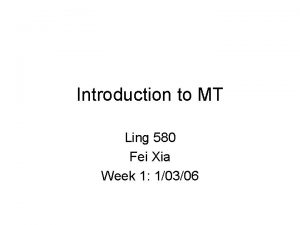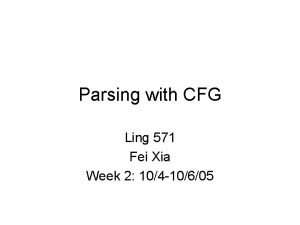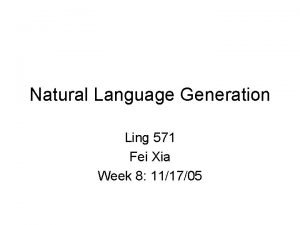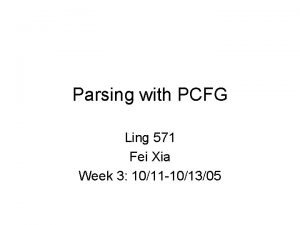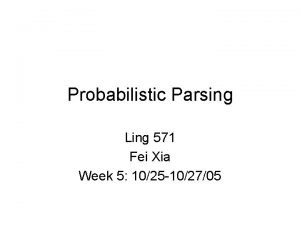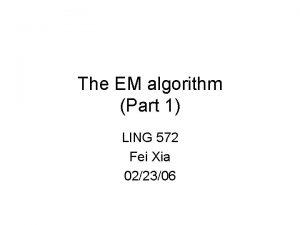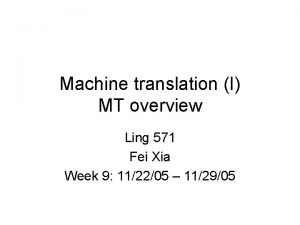Introduction LING 572 Fei Xia Week 1 1306

















































- Slides: 49

Introduction LING 572 Fei Xia Week 1: 1/3/06

Outline • Course overview • Problems and methods • Mathematical foundation – Probability theory – Information theory

Course overview

Course objective • Focus on statistical methods that produce stateof-the-art results • Questions: for each algorithm – How the algorithm works: input, output, steps – What kind of tasks an algorithm can be applied to? – How much data is needed? • Labeled data • Unlabeled data

General info • Course website: – Syllabus (incl. slides and papers): updated every week. – Message board – ESubmit • Office hour: W: 3 -5 pm. • Prerequisites: – Ling 570 and Ling 571. – Programming: C, C++, or Java, Perl is a plus. – Introduction to probability and statistics

Expectations • Reading: – Papers are online: who don’t have access to printers? – Reference book: Manning & Schutze (MS) – Finish reading before class. Bring your questions to class. • Grade: – – Homework (3): 30% Project (6 parts): 60% Class participation: 10% No quizzes, exams

Assignments Hw 1: FSA and HMM Hw 2: DT, DL, and TBL. Hw 3: Boosting No coding Bring the finished assignments to class.

Project P 1: Method 1 (Baseline): Trigram P 2: Method 2: TBL P 3: Method 3: Max. Ent P 4: Method 4: choose one of four tasks. P 5: Presentation P 6: Final report Methods 1 -3 are supervised methods. Method 4: bagging, boosting, semi-supervised learning, or system combination. P 1 is an individual task, P 2 -P 6 are group tasks. A group should have no more than three people. Use ESubmit Need to use others’ code and write your own code.

Summary of Ling 570 • • • Overview: corpora, evaluation Tokenization Morphological analysis POS tagging Shallow parsing N-grams and smoothing WSD NE tagging HMM

Summary of Ling 571 • • • Parsing Semantics Discourse Dialogue Natural language generation (NLG) Machine translation (MT)

570/571 vs. 572 • 572 focuses more on statistical approaches. • 570/571 are organized by tasks; 572 is organized by learning methods. • I assume that you know – The basics of each task: POS tagging, parsing, … – The basic concepts: PCFG, entropy, … – Some learning methods: HMM, FSA, …

An example • 570/571: – POS tagging: HMM – Parsing: PCFG – MT: Model 1 -4 training • 572: – HMM: forward-backward algorithm – PCFG: inside-outside algorithm – MT: EM algorithm All special cases of EM algorithm, one method of unsupervised learning.

Course layout • Supervised methods – Decision tree – Decision list – Transformation-based learning (TBL) – Bagging – Boosting – Maximum Entropy (Max. Ent)

Course layout (cont) • Semi-supervised methods – Self-training – Co-training • Unsupervised methods – EM algorithm • Forward-backward algorithm • Inside-outside algorithm • EM for PM models

Outline • Course overview • Problems and methods • Mathematical foundation – Probability theory – Information theory

Problems and methods

Types of ML problems • • • Classification problem Estimation problem Clustering Discovery … A learning method can be applied to one or more types of ML problems. We will focus on the classification problem.

Classification problem • Given a set of classes and data x, decide which class x belongs to. • Labeled data: – (xi, yi) is a set of labeled data. – xi is a list of attribute values. – yi is a member of a pre-defined set of classes.

Examples of classification problem • Disambiguation: – Document classification – POS tagging – WSD – PP attachment given a set of other phrases • Segmentation: – Tokenization / Word segmentation – NP Chunking

Learning methods • Modeling: represent the problem as a formula and decompose the formula into a function of parameters • Training stage: estimate the parameters • Test (decoding) stage: find the answer given the parameters

Modeling • Joint vs. conditional models: – P(data, model) – P(model | data) – P(data | model) • Decomposition: – Which variable conditions on which variable? – What independent assumptions?

An example of different modeling

Training • Objective functions: – Maximize likelihood: – Minimize error rate – Maximum entropy – …. • Supervised, semi-supervised, unsupervised: – Ex: Maximize likelihood • Supervised: simple counting • Unsupervised: EM

Decoding • DP algorithm – CYK for PCFG – Viterbi for HMM –… • Pruning: – Top. N: keep top. N hyps at each node. – Beam: keep hyps whose weights >= beam * max_weight – Threshold: keep hyps whose weights >= threshold –…

Outline • Course overview • Problems and methods • Mathematical foundation – Probability theory – Information theory

Probability Theory

Probability theory • Sample space, event space • Random variable and random vector • Conditional probability, joint probability, marginal probability (prior)

Sample space, event space • Sample space (Ω): a collection of basic outcomes. – Ex: toss a coin twice: {HH, HT, TH, TT} • Event: an event is a subset of Ω. – Ex: {HT, TH} • Event space (2Ω): the set of all possible events.

Random variable • The outcome of an experiment need not be a number. • We often want to represent outcomes as numbers. • A random variable is a function that associates a unique numerical value with every outcome of an experiment. • Random variable is a function X: Ω R. • Ex: toss a coin once: X(H)=1, X(T)=0

Two types of random variable • Discrete random variable: X takes on only a countable number of distinct values. – Ex: Toss a coin 10 times. X is the number of tails that are noted. • Continuous random variable: X takes on uncountable number of possible values. – Ex: X is the lifetime (in hours) of a light bulb.

Probability function • The probability function of a discrete variable X is a function which gives the probability p(xi) that the random variable equals xi: a. k. a. p(xi) = p(X=xi).

Random vector • Random vector is a finite-dimensional vector of random variables: X=[X 1, …, Xk]. • P(x) = P(x 1, x 2, …, xn)=P(X 1=x 1, …. , Xn=xn) • Ex: P(w 1, …, wn, t 1, …, tn)

Three types of probability • Joint prob: P(x, y)= prob of x and y happening together • Conditional prob: P(x|y) = prob of x given a specific value of y • Marginal prob: P(x) = prob of x for all possible values of y

Common equations

More general cases

Information Theory

Information theory • It is the use of probability theory to quantify and measure “information”. • Basic concepts: – Entropy – Joint entropy and conditional entropy – Cross entropy and relative entropy – Mutual information and perplexity

Entropy • Entropy is a measure of the uncertainty associated with a distribution. • The lower bound on the number of bits it takes to transmit messages. • An example: – Display the results of horse races. – Goal: minimize the number of bits to encode the results.

An example • Uniform distribution: pi=1/8. • Non-uniform distribution: (1/2, 1/4, 1/8, 1/16, 1/64, 1/64) (0, 110, 111100, 111101, 111110, 111111)

Entropy of a language • The entropy of a language L: • If we make certain assumptions that the language is “nice”, then the cross entropy can be calculated as:

Joint and conditional entropy • Joint entropy: • Conditional entropy:

Cross Entropy • Entropy: • Cross entropy is a distance measure between p(x) and q(x): p(x) is the true probability; q(x) is our estimate of p(x).

Cross entropy of a language • The cross entropy of a language L: • If we make certain assumptions that the language is “nice”, then the cross entropy can be calculated as:

Relative Entropy • Also called Kullback-Leibler distance: • Another distance measure between prob functions p and q. • KL distance is asymmetric (not a true distance):

Relative entropy is non-negative

Mutual information • It measures how much is in common between X and Y: • I(X; Y)=KL(p(x, y)||p(x)p(y))

Perplexity • Perplexity is 2 H. • Perplexity is the weighted average number of choices a random variable has to make.

Summary • Course overview • Problems and methods • Mathematical foundation – Probability theory – Information theory M&S Ch 2

Next time • FSA • HMM: M&S Ch 9. 1 and 9. 2
 Fei fei li
Fei fei li Fei fei li
Fei fei li Ssd 1306
Ssd 1306 Cosc 1306
Cosc 1306 Cosc 1306
Cosc 1306 Music 1306
Music 1306 Cosc 1306
Cosc 1306 Jelaskan chord apa yang disusun oleh nada 572
Jelaskan chord apa yang disusun oleh nada 572 Cse 572
Cse 572 Csci572
Csci572 Ese 572
Ese 572 Data mining
Data mining Find the odd one : 396, 462, 572, 427, 671, 264
Find the odd one : 396, 462, 572, 427, 671, 264 Week by week plans for documenting children's development
Week by week plans for documenting children's development Dinastiyang hsia
Dinastiyang hsia Guoxing xia
Guoxing xia Tengbo li
Tengbo li Dr xia wang
Dr xia wang Peking opera masks
Peking opera masks Mga dinastiya sa sinaunang tsina
Mga dinastiya sa sinaunang tsina Longest chinese dynasty
Longest chinese dynasty Albert xia
Albert xia Wo men de tian fu
Wo men de tian fu Lingxiao xia
Lingxiao xia Zhou dynasty achievements
Zhou dynasty achievements Guoxing xia
Guoxing xia Xia red
Xia red Molecular clock hypothesis
Molecular clock hypothesis Laura iordache
Laura iordache Bps courses uottawa
Bps courses uottawa Qfrost
Qfrost Xia red
Xia red Yuni xia
Yuni xia Guoxing xia
Guoxing xia Exces de cerere
Exces de cerere Chinese dynasties song
Chinese dynasties song Amy xia amgen
Amy xia amgen Xuhua xia
Xuhua xia Perfume xia xiang
Perfume xia xiang Kñp
Kñp Patrick xia
Patrick xia Lirong xia
Lirong xia Lirong xia rpi
Lirong xia rpi Qiangfei xia
Qiangfei xia Monsoons
Monsoons Fei dressage tests
Fei dressage tests Dow fei
Dow fei Fei duas barras sendo uma de ferro e outra de aluminio
Fei duas barras sendo uma de ferro e outra de aluminio Ufpr eça de queiroz afirmava
Ufpr eça de queiroz afirmava Zhou mei sheng
Zhou mei sheng
